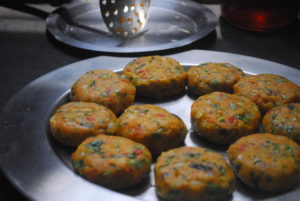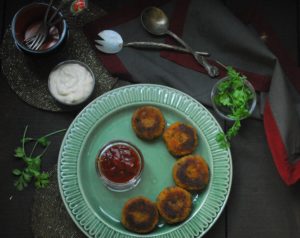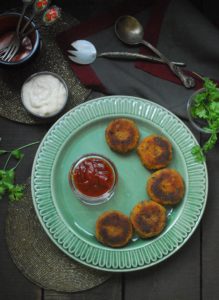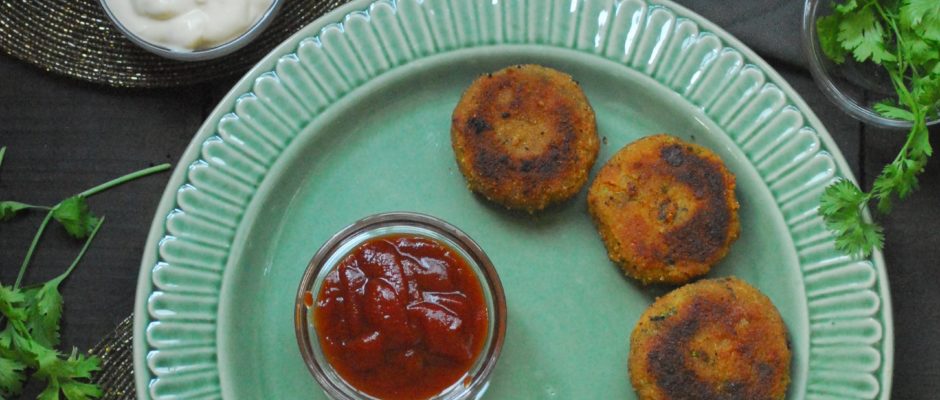Simplicity Coimbatore , Leftover veggies in a cutlet/a
The cutlet features in almost every known cuisine across the world. I wouldn’t be surprised if each country thought of this particular snack as their own invention. It is a dish which is so familiar to us, earning street food status even, that it would be astonishing to think that it could have it’s origins anyplace else…right ?!
The word cutlet is derived from the French word “cotelette” which essentially means a piece of (rib) meat taken from lamb or pork ,which was then dipped in egg, breaded and deep fried. Cutlets soon started becoming very popular in the mid to late 1600s in most of Europe.
With colonisation and trade, the cutlet began to make it’s appearance in far flung places across the globe. Different kinds of ingredients began to surface based on the geographical location. Chicken, prawn ,fish, veal ,egg , vegetables ;all cooked in a similar manner began to be referred to as a cutlet.
The cutlet also has many native inferences. Here are a few; pollo empanizado (Cuba) , katsuretsu (Japan) , cotoletta (Italy) , Kotlet (Poland), sichenyk (Ukraine) ,kotleta (Russia) , Kotellet (Germany). In SriLanka and India it is simply known as ‘cutlet’ while in the UK it is also common to call it ‘chops’ again referring to the same process of dipping in an egg wash before coating in bread crumbs and deep frying.

The origin of the cutlet in India is interesting. Rather than it being a trade of recipes as one would assume it actually has to do with the introduction of potatoes to the Indian sub-continent. According to writer Bisma Tirmizi ,she writes in an article that potatoes were probably brought to India by Portugese or Dutch travelers. She also mentions a story about Governor General Warren Hastings (Bengal) being gifted a sack of potatoes by the Dutch ,at an official dinner. She mentions that in the late 1800s ,Lord Amherst ordered that potatoes be planted at the park at Barrackpore (a British cantonment to the north of Kolkata).
She also adds that potatoes took their time in traveling to the South of India. The first time it was brought to Hyderabad was by another British gentleman who actually hired armed guards to safeguard the precious commodity during transportation. No taking the humble potato for granted anymore ! The lockdown is a good time to understand the scarcity of fresh produce even better.
The story goes that the Bengalis took to the potatoes almost instantly and enjoyed the flavour pairings with their beloved mustard oil. Even today the cutlet is a much sought after dish in Kolkata , especially among the Anglo-Indian community.
When thinking about using leftovers to create a dish, I realised the cutlet wasn’t very different from the kai kari mandi of Chettinad. It’s a dish which is made at the end of the week using leftover vegetables. When we have a couple of potatoes, a carrot, some beans and maybe a few florets of cauliflower ,a cutlet seems an ideal way to use up all those ingredients and stretch it to make a dish for the family. That’s just what I did this past week and if I say so myself it was one of the best cutlets we had ever made. The thought behind making a dish invokes feelings and sentiments which are always positive and translate by adding an extra dollop of flavour . Very often we hear cooks say that ‘love’ is the main ingredient. With complete conviction as someone who cooks with love for friends and family this ingredient is not something to be discounted,not in the least !

Traditional cutlet recipes using minced meat do use cooked potato to act as a binding agent. So, meat and potatoes formed the base ingredients of a good cutlet. As it found it’s way into Indian kitchens, the potato began to emerge as the hero .With the vast array of green herbs, whole spices, pounded masalas and taste buds used to a bit of zing, Indians welcomed the emergence of the ; aloo tikki, vada pav and the vegetable cutlet as we like to call it here in Coimbatore.
The vegetarian foodie in us didn’t stop there. We have brown rice cutlets, paneer cutlets, murungakkai cutlets, yam ,soya, tofu, oats and so much more. But every once in awhile the good old vegetable cutlet finds its way back to our plates. Shallow fried not deep fried. Yes !… that’s another thing we can stake claim for in addition to making this completely vegetarian.
Pre-cooking the ingredients ensured that all this needed was to crisp up on the surface for which a simple shallow frying or even a few minutes on a lightly oiled tava would do. Another step which changed was the egg dipping. We have so many more vegetarian options .While most folks like to coat the cutlets in a maida (refined flour) or a cornflour slurry , healthier options include a gram flour and water (slurry) dip before coating it in crumbs.
For those of us who cannot tolerate wheat, cutlets can be coated in a powdered peanuts or powdered rice flakes . A friend coats her cutlets with thin shavings of copra (dried coconut). It is apparently delicious though I am yet to try it.
Then comes the add ons ; mint chutney , ketchup ,spiced hung curd, tamarind chutney…so many choices. Making the cutlets gave me a sense of satisfaction. I was using up bits and pieces of veggies to make something tasty which the family could enjoy while sitting around the table and trying to be upbeat about the bizarre situation which we find ourselves in.
A blogger from Coorg recently mentioned that we tend to eat more during this lockdown period because we are trying to fill that void of uncertainty in some way. Cooking and sharing food makes us feel like we are still creating , doing , living…. it’s a beautiful thought and one that I would like to hang on to whenever necessary.
The veggie cutlets weren’t devoured, they were savoured and this time alone I indulged them with an extra helping of ketchup.



No comments yet.